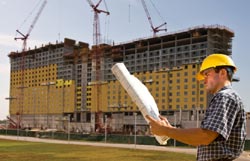Benefits of Specifying NABA

As an architect, specification writer, consultant or building owner, you want assurance that the job will be done right. In the case of the air barrier system, you are, in most cases, dealing with a non-maintainable building component.
As time progresses architects, engineers, specification writers and consultants are becoming more and more liable for the buildings they design. In the case of the air barrier system, it is estimated the cost of retrofit and repair of an improper system is 50 - 60 times that of doing it right the first time.
The entire Quality Assurance Program is administered, in all aspects, by third party organizations that specialize in QAP administration for the construction industry. This ensures all contractors and installers must meet the same high standards.
Some of the benefits of including NABA in your contractor specifications are:
- Reduction of liability by making the contractor and installer more accountable. Without NABA, the architect takes on the responsibility for proper installation
- Un-certified installers may mean that they have no prior experience in installing air barriers
- NABA installers are mandated to check all aspects of the installation from substrate conditions to post installation deficiencies so the mind set of the installers is different. Various test methods are used by the installer to confirm his workmanship.
- NABA installers keep mandatory daily work sheets and provide a paper trail of the entire Air / Vapour Barrier Installation. These are kept on file at the NABA office, and the design professional may request copies
- Using the NABA installation specification means that the architect has a confidence level that the installation will be done correctly
- NABA installations will be subject to random field installer audits.
- NABA will provide advise and recommendations for various installation details
- NABA will provide leadership in new and better installation practices and design.
- Architects have limited resources to check past performance or credentials of installers
- Architects have no authority over the installers, they can only recommend non-payment to the contractor if the installation is deficient. NABA has authority over both the installer and the contractor
- Contractors and installers have signed legal agreements with NABA to do the job properly.
- NABA fosters the sharing of expertise amongst the members so that all learn from the experiences of others.
- Architects are limited with time and resources to follow up on the quality of the installation
- NABA acts as a mediator between the contractor and the owner or architect in cases were installation problems arise.
How do I Specify the NABA QAP?
We always recommend design professionals using our Division 7 air barrier master specifications for the project but if the design professional has a generic air barrier specification already written, simply reference that the Air Barrier Contractor needs to be NABA-Accredited and the Installer needs to be NABA-Certified. Particularly, if you add Section 1.3 line .2 (Quality Assurance Program (QAP)), line .8 (Air Barrier Subcontractor Qualifications) or line .12 (Field Quality Assurance), you will ensure that you will receive the NABA QAP and it's benefits including, Accredited Air Barrier Contractor, Certified Installers and third-party audits.
What are Costs for the NABA QAP?
There are upfront one-time costs for a project that is specified with the NABA QAP.
Since we have Auditors that inspect every job, those costs of the inspections are added into the Air Barrier Contractors bid price. NABA and the auditing firm will communicate that with the Air Barrier Contractor but typically they will be no less than $1000. The number of audits specified is dependent on how many the design professional specifies. The scale on the number of audits that NABA recommends can be found in Section 3 of all of our master specifications.
We also charge $0.06 per square foot of NABA-QAP specified for air barrier for projects within a 200km radius of the centre of the nearest major city and $0.10 per square foot for projects outside of a 200km radius of the centre of the nearest major city. Major cities are those including Vancouver, Victoria, Calgary, Edmonton, Saskatoon, Regina, Winnipeg, Ottawa, Toronto, Mississauga, Windsor, Kingston, Hamilton, London, Quebec City, Montreal, Charlottetown, Moncton, St. John's, Fredericton, Moncton, Charlottetown and Saint John.
The General Contractor needs to ensure that the awarded contract is awarded to a NABA-Accredited Contractor because if it isn't, the costs factored into the bid may not be comparable from a NABA-Accredited Contractor and a non NABA-Accredited Contractor.
NABA Five Levels of Service
NABA is excited to have launched our new five levels of service in May 2013. The five levels of service is additional value-added services that the design professional can specify along with their NABA QAP project. These services include hygrothermal analysis of the building envelope design, design review which includes ensuring continuity and compatibility of all of the materials in the air barrier system, additional building envelope inspections, whole building air leakage testing and IR camera/smoke testing and a warranty. For more information, click here for our brochure on these services.
NABA itself does not complete this work, we contract it out to third-party building envelope experts who we work with and have a great working relationship with.
For more information on these services, please contact us at 1.866.268.NABA or naba@naba.ca.
